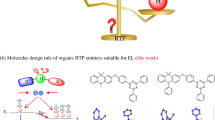Abstract
The conditions to prepare luminescent acrylate polymers containing the organic dyad, molecule of which combines two different emitting fragments, hydroxyl-substituted 2,4,5–triarylimidazole and 8-azomethine-7-hydroxycoumarine moieties, via photocuring have been optimized. The effect of the nature of the photocured network acrylate polymers on luminescent properties of the dyad has been investigated. The prepared aliphatic network polymers have exhibited independent fluorescence of both molecule fragments, dependent on the excitation wavelength. At the same time, the aromatic network polymers and the aliphatic network polymers containing ether links have revealed only the imidazole fragment fluorescence. The fluorescence nature has been stronger dependent on the polymer repeat unit structure and the content of the aromatic fragments in the polymer matrix than on the presence of the hydroxyl groups in the polymer. It has been shown that the emission of the imidazole fragment of the dyad in the aliphatic network polymers depends on the internode distance and conditional polarity of the medium.






Similar content being viewed by others
REFERENCES
B. M. Krasovitskii and B. M. Bolotin, Organic Luminescent Materials (Wiley-VCH, Weinheim, 1988).
H. Klauk, Organic Electronics: Materials, Manufacturing, and Applications (Wiley-VCH, Weinheim, 2006).
S. Ji. Zhao, Y. Chen, H. Guo, and P. Yang, Phys. Chem. Chem. Phys. 14, 8803 (2012).
S. Y. Park, M. Won, C. Kang, J. S. Kim, and M. H. Lee, Dyes Pigm. 164, 341 (2019).
G. Brancato, G. Signore, Y. Neyroz, D. Polli, G. Cerullo, G. Abbandonato, L. Nukara, V. Barone, F. Belytan, and R. Bizzari, J. Phys. Chem. B. 119, 6144 (2015).
H. Liu, F. Lin, M. Chen, and K. Hu, Iran. Polym. J. 19 (3), 219 (2010).
R. Chakraborty and M. D. Soucek, Eur. Polym. J. 44, 3326 (2008).
K. Bowling, J. Adams, and S. Struck, J. Coat. Technol. 68, 91 (1996).
S. K. Rath, A. Diby, Z. Seghier, F. Y. C. Boey, and M. J. M. Abadie, Iran. Polym. J. 15, 855 (2006).
H. Liu, L. Yu, M. Chen, and Z. Huang, Mater. Res. Bull. 38, 1607 (2003).
R. Bongiovanni, G. Malucelli, M. Messori, F. Pilati, A. Priola, C. Tonelli, and M. Toselli, J. Appl. Polym. Sci. 75, 651 (2000).
V. S. Padalkar and S. Seki, Chem. Soc. Rev. 45, 169 (2016).
S. Park, J. E. Kwon, S. H. Kim, J. Seo, K. Chung, D. J. Jang, B. W. Medina, J. Giecher, and S. Y. Park, J. Am. Chem. Soc. 131, 14043 (2009).
E. Heyer, J. Nassue, and G. Ulrich, Dyes Pigm. 143, 18 (2017).
S. Tasaki, A. Momotake, Y. Kanna, T. Sato, Y. Nishimura, and T. Arai, Photochem. Photobiol. Sci. 14, 1864 (2015).
A. V. Liubimov, O. V. Venidiktova, T. M. Valova, A. I. Shienok, L. S. Koltsova, G. V. Liubimova, L. D. Popov, N. L. Zaichenko, and V. A. Barachevsky, Photochem. Photobiol. Sci. 17, 1365 (2018).
I. A. Matveeva, V. T. Shashkova, A. V. Liubimov, G. V. Liubimova, L. S. Koltsova, A. I. Shienok, and N. L. Zaichenko, Russ. J. Phys. Chem. B 13, 803 (2019).
A. A. Berlin, G. V. Korolev, T. Ya. Kefeli, and Yu. M. Sivergin, Acrylic Oligomers and Materials on Their Basis (Nauka, Moscow, 1983) [in Russian].
D. W. Van Krevelen and P. J. Hoftyzer, Properties of Polymers: Correlations with Chemical Structure (Elsevier, London; New York, 1972).
Funding
This study was financially supported by the Ministry of Science and Higher Education of the Russian Federation in the scope of the State Task FFZE-2022-0009 to Federal Research Center for Chemical Physics, RAS.
Author information
Authors and Affiliations
Corresponding author
Ethics declarations
The authors declare that they have no conflicts of interest.
Additional information
Translated by E. Karpushkin
Rights and permissions
About this article
Cite this article
Matveeva, I.A., Shashkova, V.T., Lyubimov, A.V. et al. Special Features of Multiple Luminescence of the Dyad Containing Imidazole and Coumarin Fragments in Photocured Network Acrylate Polymers. Polym. Sci. Ser. B 65, 496–504 (2023). https://doi.org/10.1134/S1560090423701117
Received:
Revised:
Accepted:
Published:
Issue Date:
DOI: https://doi.org/10.1134/S1560090423701117




